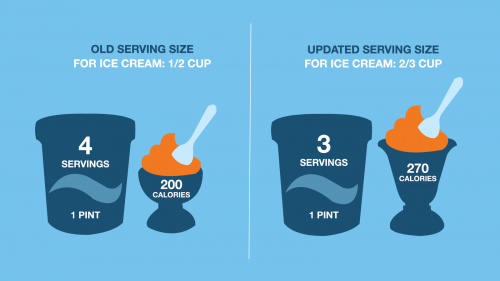Where Can Someone Find Out What A Recommended Serving Size Should Be For Ice Cream Or Pasta?
Nutrient Serving Sizes Take a Reality Bank check
Image

Español
The final fourth dimension you scooped some ice cream for dessert, did you lot limit yourself to one-half a loving cup? If yous took more—you lot're right in step with almost people these days.
Likewise with a soft beverage: Do y'all drink 8 ounces, 12 ounces, or fifty-fifty the whole 20-ounce bottle?
Ice cream and soft drinks are just 2 nutrient products that have been affected by changes in serving size requirements that are included in the updated Nutrition Facts characterization. The goal: to bring serving sizes closer to what people really eat so that when they look at calories and nutrients on the label, these numbers more closely match what they are consuming.
The serving sizes listed on the Nutrition Facts label are not recommended serving sizes. Past law, serving sizes must exist based on how much food people really eat, and not on what they should eat.
In 1993, when the U.S. Nutrient and Drug Administration created the Nutrition Facts label, the standards used to make up one's mind serving sizes—chosen the Reference Amounts Customarily Consumed (RACCs)—were based primarily on surveys of nutrient consumption conducted in 1977-1978 and 1987-1988. The 1993 RACCs were used by manufacturers for over 20 years to calculate the serving sizes on their packages.
The updated RACCs used to set the requirements for serving sizes on packages are now based on 2003 to 2008 data from the National Health and Nutrition Exam Surveys.
In some cases, the reference amounts used to set up serving sizes are smaller. Today'due south individually packaged yogurts more often come in 6-ounce containers, versus the previous 8-ounce ones. The FDA is now using a half dozen-ounce reference amount for yogurt.
But the serving size for water ice cream is at present a piddling larger. Instead of a half of a cup, it's now 2-thirds of a cup.
Changes Based on Parcel Size
The FDA too changed the criteria for labeling based on package size. With the updated requirements, more than food products previously labeled as more than than one serving are at present required to be labeled as merely one serving. Why? Because people are more likely to eat or drink the entire container or particular in one sitting. Examples include a 20-ounce tin can of soda, and a xv-ounce tin of soup. And many large muffins that were previously labeled as ii or even iii servings will be labeled as a single serving under the updated requirements, consistent with how people generally consume them.
Certain larger packages that may be consumed either in one sitting or more than ane sitting—depending on your appetite and inclination—must now be labeled both per serving and per package. This dual-column format is required if a packet contains at least two times the reference amount customarily consumed (on which the serving size is based) and less than or equal to three times the reference amount. Some examples are a 19-ounce can of soup and three-ounce bag of chips.
Previously, manufacturers were only required to provide the calorie and nutrient information per serving, and you would have to do the math if you're eating the whole container. And then if you accept a hankering for some fries and eat an unabridged package, now you'll have easier access to information almost what you're consuming.
For packages that are conspicuously larger than well-nigh people would eat in one sitting—i that has more than 3 servings—the dual column is not required. Manufacturers are only required in these cases to label these products per serving. Examples include a "party size" pocketbook of chips or a two-liter bottle of soda.
The FDA hopes the updated label will brand it easier for people to make up one's mind the number of calories and nutrients they're actually consuming and then they can ultimately make healthier food choices for themselves and their families.
Where Can Someone Find Out What A Recommended Serving Size Should Be For Ice Cream Or Pasta?,
Source: https://www.fda.gov/consumers/consumer-updates/food-serving-sizes-have-reality-check
Posted by: treatsmandertne.blogspot.com


0 Response to "Where Can Someone Find Out What A Recommended Serving Size Should Be For Ice Cream Or Pasta?"
Post a Comment